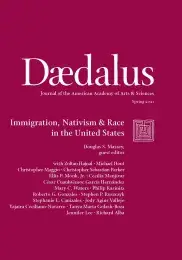The Bipartisan Origins of White Nationalism
Dysfunctional immigration and border policies implemented in recent decades have accelerated growth of the Latino population and racialized its members around the trope of illegality. Since the 1960s, Republicans have cultivated White fears and resentments toward African Americans, and over time these efforts broadened to target Hispanics as well. Until 2016, this cultivation relied on a dog whistle politics of racially coded symbolic language, but with the election of Donald Trump as president, White nationalist sentiments became explicit and White nationalism emerged as an ideological pillar of the Republican Party. This volume confirms this political transformation, describing its features and documenting its consequences. In this essay, I describe the unwise U.S. immigration and border policies that were steadily promulgated and expanded over the decades by Democrats as well as Republicans, inevitably leading to the current racist and nativist moment. I close by offering a way forward by granting legal status to those who currently lack it, while simultaneously dismantling the nation’s formidable machinery of immigration and border enforcement.
In 2016, Donald Trump was elected president of the United States on a wave of White nationalist sentiment that he deliberately fomented and would relentlessly cultivate during his time in office. As the essays in this issue of Dædalus make clear, America’s current racist and xenophobic moment was a long time coming. It did not begin with Trump. It followed decades in which one of the nation’s two major political parties deliberately incited White racial fears and resentments for purposes of political gain. Beginning with Richard Nixon’s “Southern strategy” in 1968 and continuing through Ronald Reagan’s evocation of the “welfare queen” stereotype in 1980, George H. W. Bush’s airing of the Willie Horton ad in 1988, and George W. Bush’s 2001 appointment of a neo-Confederate as Attorney General, Republicans developed and deployed a “dog whistle” politics of symbolic appeals to racial fears and biases.1 Trump simply threw away the whistle.
Although Republican fearmongering and race-baiting initially focused on African Americans, over time it broadened to include the nation’s growing Hispanic population. In the process, the Mexican-U.S. border was militarized and transformed into a potent symbol of ethnoracial exclusion.2 The framing of the border as a line of defense against alien invaders dates to 1976, when the commissioner of the Immigration and Naturalization Service (a former Marine Corps general and Nixon appointee) published an article in Reader’s Digest alleging that a “silent invasion of illegal aliens” was threatening the nation and that a budget increase for his agency was “desperately needed to help us bring the illegal alien threat under control.”3 With the election of Jimmy Carter later that year, however, Chapman’s plea remained unfulfilled until 1986, when Ronald Reagan signed the Immigration Reform and Control Act.
The great irony is that the resulting militarization of the border did not curtail the unauthorized entry of Mexicans. Instead it ended circular migration, reducing the rate of return migration back to Mexico while leaving in-migration unaffected, thereby increasing the net volume of unauthorized migration and accelerating rather than reducing undocumented population growth to hasten the “browning” of the nation so feared by nativists.4 From 1988 to 2008, the estimated size of the undocumented population rose from two million to twelve million persons and the nation’s Hispanic population rose from 13.1 percent to 15.4 percent of the total. The Hispanic share today stands at 18.3 percent, with 34.4 percent being foreign born and 36.5 percent of those born abroad being undocumented.5
The net inflow of undocumented migrants was greatest during the 1990s. It began to slow after 2000 and came to an abrupt halt with the onset of the Great Recession in late 2007.6 Although the recession may have been the proximate cause of the sudden end of undocumented migration from Mexico, the underlying cause was a sharp decline in Mexican fertility after 1970, which brought about the rapid aging of the Mexican population. Labor migration is highly age dependent. Rates of departure rise in the late teens, peak around age twenty-two or twenty-three, and then decline rapidly to low levels by age thirty and above. Between 1975 and 2020, the median age in Mexico rose from seventeen to twenty-nine and the rate of undocumented out-migration consequently fell to record low levels.7 While 1.6 million Mexicans were apprehended along the border in 2000, by 2017, the number had fallen to just 128,000, despite the fact that the number of Border Patrol agents trying to catch them had risen from 9,000 to 19,000.8
Since the Great Recession, undocumented migration from Mexico has been net negative, and the estimated number of undocumented Mexicans living in the United States declined by 23 percent between 2010 and 2018.9 Indeed, when Trump declared his candidacy in 2016 and promised to build his two-thousand-mile border wall, undocumented Mexican migration had been effectively over for nearly a decade. With few Mexicans arriving at the border, once in office, he focused his fearmongering on Central Americans. Although migrants had been exiting El Salvador, Guatemala, and Honduras since the U.S. interventions of the 1980s, their modest numbers historically were obscured by the much larger number of Mexicans arriving at the border. By 2019, however, the Mexicans were largely gone and Central Americans accounted for 71 percent of all those apprehended at the border.10
Despite the continued arrival of migrants from Central America, unauthorized border crossings are no longer the principal source of undocumented population growth. Whereas the undocumented Central American population did grow by around 19 percent between 2010 and 2018, the corresponding rate was 22 percent for undocumented Chinese, 69 percent for undocumented Indians, and 164 percent for undocumented Venezuelans. Migrants from these countries enter the United States by overstaying visas rather than surreptitiously crossing the border. Together, their arrival, along with Central Americans, partially offset the loss of Mexicans from the undocumented population; but the total number of unauthorized U.S. residents nonetheless fell by 10 percent between 2010 and 2018.11
Although undocumented migration from Central America continues and legal immigration from Latin America has by no means ended, Hispanic population growth is now driven primarily by an excess of births over deaths rather than net in-migration. The total fertility rate for Hispanic Americans today is 2.01 (children per woman) compared with 1.67 for White Americans and 1.82 for Black Americans.12 Even though all three rates are below replacement level fertility (roughly 2.1), Hispanics are nonetheless increasing their share of the population because they are a much younger population with a larger share of women of childbearing age, thus amplifying the effect of the small fertility differential.
Whereas Hispanics constituted just 4.7 percent of the U.S. population in 1970, by 2019, their share had reached 18.3 percent, with 12.7 percent for Blacks and 5.7 percent for Asians. The share of non-Hispanic Whites, meanwhile, had fallen to around 60 percent.13 The rising share of Hispanics in the electorate helped to provide Barack Obama with winning margins in two elections, with 67 percent voting for him in 2008 and 71 percent in 2012.14 Together, the rapid growth of the Hispanic population and the election of Barack Obama as president of the United States were critical in sparking the White nationalist reaction that elected Donald Trump in 2016.15 But as already noted, Trump was building on a long Republican history of exploiting race as a wedge issue.
In his contribution to this volume, “Immigration & the Origins of White Backlash,” Zoltan Hajnal marshals abundant evidence to demonstrate that Trump’s mobilization of reactionary sentiment in 2016 was simply an extension of a long-term Republican project of fomenting White racial fears and resentments. He explains how Republicans steadily increased their share of the White vote by scapegoating immigrants and promising to curtail undocumented migration. Since 1990, votes in Congress have increasingly displayed a stark division between Republicans who favor restrictive laws and punitive measures against immigrants, and Democrats who favor more open immigration policies and defend immigrant rights. Hajnal concludes that “a backlash to immigration is helping drive this most significant development in American party politics in the twenty-first century.”
Hajnal’s view is supported by Michael Hout and Christopher Maggio’s analysis in their essay, “Immigration, Race & Political Polarization,” of data collected from White likely voters by the General Social Survey. Whereas, in 1994, substantial majorities of Whites in both political parties favored restrictions on immigration, by 2018, the share supporting restriction had fallen to 21 percent among Democrats but remained at 62 percent among Republicans. The partisan division in White attitudes toward immigrants is paralleled by a similar division in attitudes toward African Americans. Using an index of anti-Black resentment they developed, Hout and Maggio show that between 1994 and 2018, White resentment toward Blacks fell sharply among Democrats while it barely budged among Republicans, opening up a huge 46 percent gap between the two parties. Drawing on data from the 2016 Cooperative Congressional Election Survey, they show that Whites who favored restricting immigration and expressed racial resentment toward Blacks were far more likely to vote for Trump than Whites who did not hold these views.
The foregoing analyses suggest that anti-Black resentments and anti-immigrant attitudes have increasingly become intertwined over time, a conclusion sustained by Christopher Parker in his contribution “Status Threat: Moving the Right Further to the Right?” He argues that the election of Barack Obama against the backdrop of a browning America created a powerful threat to White status, fueling a bitter politics that is not just conservative, but reactionary. The Republican base today seeks not simply to preserve the social structures and practices that historically ensured White privilege; they wish to restore an imagined past in which Black and brown people knew and accepted their subordinate place in the social order. In a well-controlled analysis, Parker’s index of status threat strongly predicts White support not only for immigration restriction, but opposition to Trump’s impeachment and support for his reelection, holding constant the effects of racism, authoritarianism, social dominance, ideological conservatism, and exposure to Fox News.
The emergence of reactionary racial resentment against Blacks and Hispanics as a fundamental pillar of support for the Republican Party is perhaps unsurprising given the long history of skin color stratification in the United States. As President Lyndon Johnson once observed, “If you can convince the lowest White man he’s better than the best colored man, he won’t notice you’re picking his pocket. Hell, give him somebody to look down on, and he’ll empty his pockets for you.”16 As Ellis Monk argues in his contribution “The Unceasing Significance of Colorism: Skin Tone Stratification in the United States,” immigration has changed the racial complexion of American society in recent decades and processes of skin color stratification have broadened to incorporate dark-skinned Hispanics and Asians as well as Blacks, leading him to conclude “that the integration of new members of American society is also hampered and stratified by skin tone . . . so much so that it seems quite fair to label it a pigmentocracy.”
A distinctive feature of the racialization of Hispanics is the conflation of skin color with illegality. As Cecilia Menjívar points out in “The Racialization of ‘Illegality,’” it is the close association between suspected illegality and perceived Latin American origins that fuels the treatment of Latinos as racialized “others” in U.S. society. Laws passed in 1996 and 2001 increasingly focused the weight of anti-immigrant enforcement efforts not just along the border, but throughout the nation’s interior. In the wake of this legislation, deportations from the U.S. interior surged and Hispanics were disproportionately swept into the maw of a “formidable machinery” of apprehension, detention, and removal.17 Although the 1996 Anti-Terrorism and Effective Death Penalty Act and the USA PATRIOT Act were enacted in the name of the war on terror, Immigration and Customs Enforcement (ICE) has overwhelmingly targeted brown-skinned people who “look Hispanic,” thereby contributing to their racialization. Of the 3.7 million persons deported between 2008 and 2018, 96 percent were Latin American.18
For most of U.S. history, unauthorized entry, residence, and labor in the United States were violations of civil rather than criminal law. Until quite recently, even immigrants convicted of crimes were not routinely deported once they had completed their sentences. In his essay “Criminalizing Migration,” César Cuauhtémoc García Hernández documents the steady criminalization of immigration in the United States, a process known as “crimmigration.” Whereas in 1986 Congress enacted legislation to request that local law enforcement officers report immigrants arrested for drug crimes to immigration authorities, in 1988, it created a new legal category of “aggravated felony” and required immigration authorities to take custody of any noncitizen convicted of such an offense, including legal resident aliens.
Although aggravated felonies originally included only homicide, arms dealing, and drug trafficking, over the years the category expanded to encompass twenty-one separate offenses, including nonviolent acts common among undocumented migrants such as the use of false documents and entering without authorization after an earlier removal. Whereas criminal deportations averaged just 605 per year from 1960 through 1985, from 1986 to 2018, the yearly average rose to 83,418.19
Although crimmigration has consequences for all immigrants to the United States, the burden falls most heavily on Latinos, creating powerful barriers to immigrant integration along the lines of race and legal status. In their contribution “Race, Legal Status & Social Mobility,” Mary Waters and Philip Kasinitz note that although a lack of legal status hinders the economic integration of immigrants, it does not stop them from integrating socially. Immigrants and their children are learning English and converging with U.S. natives on most social outcomes, even as they struggle economically. According to Waters and Kasinitz, “when considering blocked mobility among immigrants and their descendants, race, while heavily correlated to legal status in the largest current immigrant groups, does not appear to be the most important factor.”
In their essay “The Legal Status Divide among the Children of Immigrants,” Roberto Gonzales and Stephen Ruszczyk depict what life is like for unauthorized migrants brought into the country as children who grew up in the United States speaking English, attending public schools, and not realizing they were undocumented. Upon entering adolescence, they gradually came to realize that their life chances were narrowly circumscribed by a legal status they did not choose and could not control. The authors argue that a lack of documentation has become what sociologists call a “master status” that overrides the influence of a person’s individual traits and characteristics in determining key life outcomes. Adolescence among undocumented teens is thus dominated by the fraught “process of learning to be illegal,” compelling them to scale back their dreams and ambitions for success in the only country they know.
Always difficult, life without documents became even more challenging under President Trump. In their contribution “Latinos & Racism in the Trump Era,” Stephanie Canizales and Jody Agius Vallejo argue that “Trump’s racist and dehumanizing rhetoric and policy actions have increased Latinos’ experiences of discrimination and institutionalized legal violence . . . while fomenting racial terrorism directed at Latinos and other groups.” They report that counties hosting rallies for Trump in 2016 experienced a 226 percent surge in hate crimes and that the number of anti-Latino hate crimes rose by 21 percent in 2018 alone.
In addition to experiencing a surge of private acts of prejudice and discrimination, Hispanics have increasingly been brutalized by President Trump’s public policies, which have accelerated the arrest, detention, and removal of immigrants from the U.S. interior. The burden of deportation falls hardest on long-term undocumented residents, most of whom now have U.S.-born citizen children. Based on 111 interviews with adult immigrants who had experienced the deportation or detention of a family member, Yajaira Ceciliano-Navarro and Tanya Golash-Boza document the devastation inflicted upon families by mass deportation in their essay “‘Trauma Makes You Grow Up Quicker’: The Financial & Emotional Burdens of Deportation & Incarceration.” All too often, the family member detained is the principal breadwinner, which causes a cascading financial crisis of lost income, rising debt, and housing instability among already poor families. Accompanying these financial challenges are profound psychological traumas, with respondents reporting intense feelings of emptiness, loss, shame, embarrassment, anger, and frustration.
Although Asians are commonly seen as America’s “model minority,” in her contribution “Asian Americans, Affirmative Action & the Rise in Anti-Asian Hate,” Jennifer Lee points out that their elevated socioeconomic standing does not shield them from racism and xenophobia. In the current political climate, the model minority stereotype of high competence but low warmth places them awkwardly between disadvantaged minorities who stand to gain from affirmative action and non-Hispanic Whites who see it as a threat. In this position, they are potentially exposed to resentment from both sides. A surge in anti-Asian incidents in the wake of the COVID-19 pandemic only serves to underscore the precariousness of their position. Even before the pandemic, anti-Asian hate crimes under Trump rose 31 percent between 2016 and 2018.
The essays in this volume clearly show that Republicans led the way in framing Latino immigrants as a grave threat to the nation while simultaneously fueling the fires of anti-Black resentment. Nonetheless, the current moment of open racism and xenophobia could not have happened without Democratic acquiescence. Although Democrats have long stated their support for immigrant rights and endorsed immigration reform in principle, in practice they served as handmaids in launching and funding the U.S. government’s war on immigrants.20 Anti-immigrant enforcement first accelerated under Ronald Reagan, but it was continued and expanded by every subsequent president, Democratic and Republican, each of whom found it politically convenient to portray Latino immigrants as a grave threat to the nation.
Ronald Reagan framed unauthorized immigration as a question of “national security” and explicitly linked it to his prosecution of the Cold War in Central America, telling Americans that “terrorists and subversives are just two days driving time from [the border crossing at] Harlingen, Texas,”21 and they could be expected to yield “a tidal wave of refugees–and this time they’ll be ‘feet people’ and not boat people–swarming into our country seeking safe haven from communist repression to the south.”22 Communist provocateurs, he alleged, would then “feed on the anger and frustration of recent Central and South American immigrants who will not realize their own version of the American dream.”23
Reagan went on to push for and sign the 1986 Immigration Reform and Control Act, which increased the number of Border Patrol agents by 50 percent and created new penalties for smuggling, harboring, and transporting unauthorized migrants. Republican control of the White House continued with the election of George H. W. Bush, and in 1990, he signed into law the last major change in U.S. immigration law. Its provisions were manifold, but in signing the bill, Bush stated that “immigration reform began in 1986 with an effort to close the ‘back door’ on immigration. Now, as we open the ‘front door’ to increased legal immigration, I am pleased that this Act also provides needed enforcement authority.”
The “front door” to which Bush referred was an increase in the global cap on numerically limited visas from 270,000 to 675,000, an expansionary provision that enabled Democrats to support the bill, even though closing the “back door” entailed the hiring of one thousand additional Border Patrol agents. The legislation also increased the penalties for immigration violations and authorized new measures to expedite removals from the United States. As in 1986, Democrats were willing to accept harsher police actions against immigrants in return for liberalization in other areas of immigration policy.
The new enforcement measures failed to stop the inflow of unauthorized migrants across the Mexican-U.S. border, of course, and in 1993, El Paso became the second-busiest sector after San Diego. Its 286,000 apprehensions amounted to forty-eight arrests for every one hundred residents, who had begun to complain bitterly about the migrants traipsing through their yards and neighborhoods. Sensing an opportunity, the local Border Patrol Chief Silvestre Reyes on his own initiative launched Operation Blockade, an all-out mobilization of enforcement resources along the city’s border with Juarez, Mexico. The operation reduced apprehensions by 72 percent over the next year and Reyes became a very popular figure locally.24 In 1996, he parlayed his popularity into election to Congress as a Democrat.
Fellow Democrat Bill Clinton took note of the apparent success of Operation Blockade and used it as a blueprint for enhancing enforcement operations along the entire border. The new policy, described in the Border Patrol report Border Patrol Strategic Plan: 1994 and Beyond, articulated a national strategy that “builds on El Paso’s success through an infusion of permanent resources designed to stabilize their enforcement initiative and extend it.” The new strategy was christened “prevention through deterrence” and its goal was to bring “a decisive number of enforcement resources to bear in each major entry corridor,” “increase the number of agents on the line, and make effective use of technology, [thereby] raising the risk of apprehension high enough to be an effective deterrent.”25
To publicize the new strategy, Attorney General Janet Reno organized a news conference along the border in San Diego, where she was joined by California Senators Barbara Boxer and Dianne Feinstein to announce the debut of Operation Gatekeeper, another all-out militarization effort designed to “restore the rule of law to the California/Baja California Border.”26 Running for reelection in 1996, Bill Clinton boasted that “our comprehensive strategy to restore the rule of law to illegal immigration enforcement has done more in three years than was done in thirty years before.”27
As in El Paso, apprehensions fell precipitously in San Diego over the ensuing year. Nonetheless, total border apprehensions continued to rise, peaking at 1.6 million in 2000. Undocumented migrants did not stop attempting to cross the border; they just staged their attempts at different locations, using routes through the Sonoran Desert into Arizona. The new routes entailed traversing a rugged, sparsely settled terrain characterized by extreme environmental conditions that threatened life and limb.
Elevating the risks of unauthorized border crossing was an explicit goal of the new policy. In the words of the Strategic Plan, “the prediction is that with traditional entry and smuggling routes disrupted, illegal traffic will be deterred, or forced over more hostile terrain, less suited for crossing and more suited for enforcement.”28 But the migrants were not deterred and, tragically, bodies piled up along the border. Prior to Operation Gatekeeper, the death toll among undocumented border crossers averaged ninety-nine per year. In the ensuing years, the toll rose to an average of 330 per year, yielding a body count of 8,239 through 2019.29
In the ensuing years, Clinton’s policy of prevention through deterrence was taken up and expanded by each successive U.S. president, whatever their party affiliation. In 2006, George W. Bush declared “we’re a nation of laws, and we must enforce our laws” and called for doubling the Border Patrol and deploying six thousand National Guard troops to the border.30 In his 2013 State of the Union Address, Barack Obama asserted that “real reform means strong border security, and we can build on the progress my administration has already made–putting more boots on the southern border than at any time in our history.”31
The bipartisan nature of support for the militarization of the Mexican-U.S. border is clearly evident in official statistics documenting the nation’s rising enforcement effort. Figure 1 shows the number of Border Patrol officers by presidential administration. Through the Johnson, Nixon, Ford, and Carter administrations, the number drifted slowly upward to level off at just below 2,500 agents during the early Reagan years. However, between 1984 and 1986, the number rose by 50 percent and remained stable until the last year of George H. W. Bush’s presidency, when it rose by a modest 12 percent. The trend line then moves sharply upward with President Bill Clinton. Upon his taking office in 2003, the Border Patrol had slightly fewer than 4,000 officers. When he left office, the force stood at 9,200 officers, an increase of 132 percent.
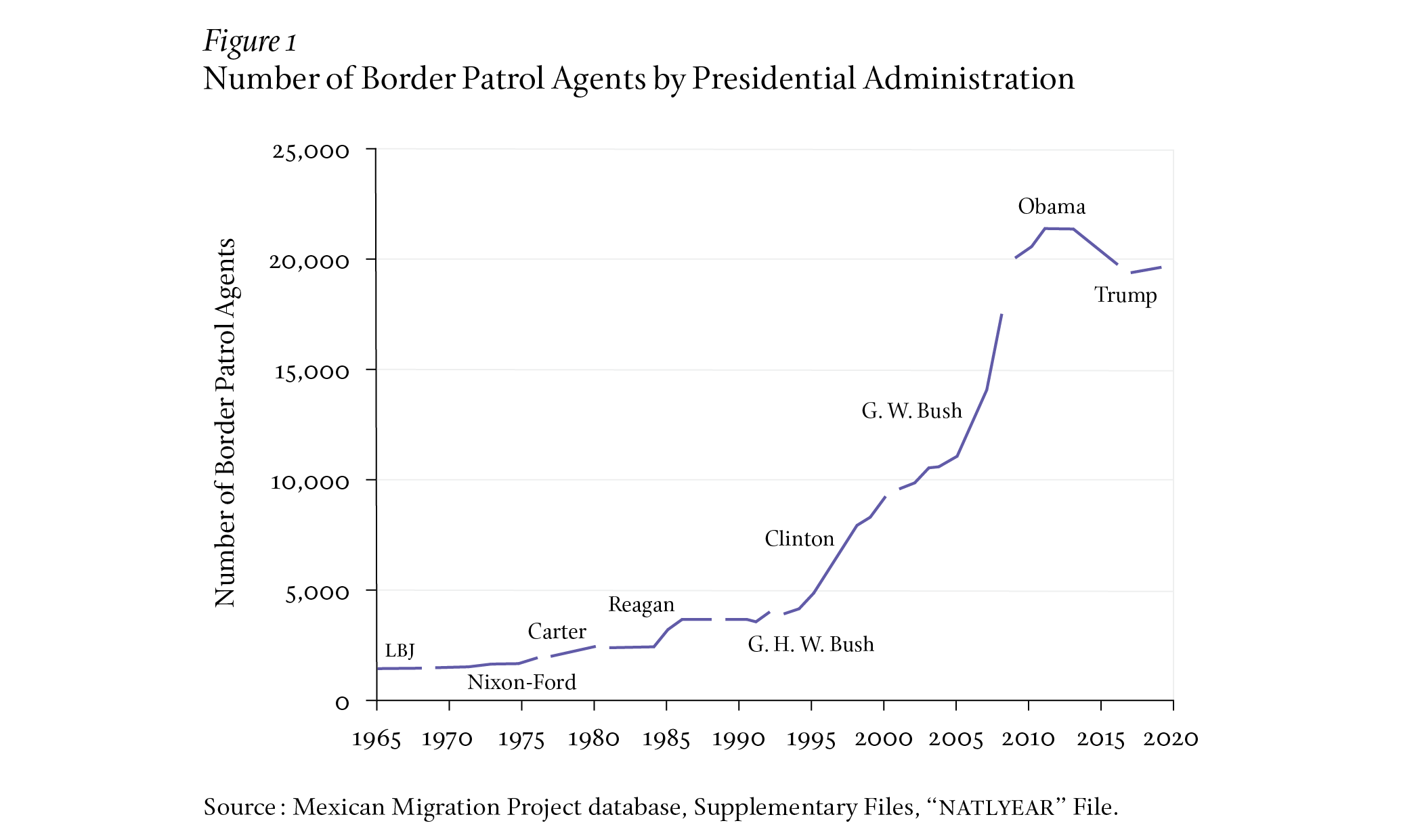
Following the attacks of September 11, 2001, border enforcement was further intensified in the name of the war on terror. During George W. Bush’s presidency, the Border Patrol grew from 9,200 to 17,500 officers, with the curve becoming almost vertical between 2005 and 2008. Upon assuming office in 2009, Barack Obama announced another surge in border enforcement in an effort to placate Republicans in hopes of pushing them toward comprehensive immigration reform. The resulting augmentation brought the Border Patrol to an all-time high of around 21,400 agents in 2011. Apparently realizing the futility of trying to lead Republicans toward a compromise on immigration reform, Obama later scaled back the corps to just under twenty thousand officers in 2016, where it has roughly remained ever since.
Rather than adding more personnel to border enforcement, President Trump chose to divert resources to build a “big, beautiful wall” along the border. As a result, although staffing of the Border Patrol leveled off, the agency’s budget did not. Figure 2 shows the trend in the size of the Border Patrol’s budget by presidential administration. As can be seen, through the second Bush administration, the trend parallels that shown in Figure 1. Thereafter, however, the budget shoots rapidly upward through both the Obama and Trump administrations, reaching a record $4.7 billion in 2019.
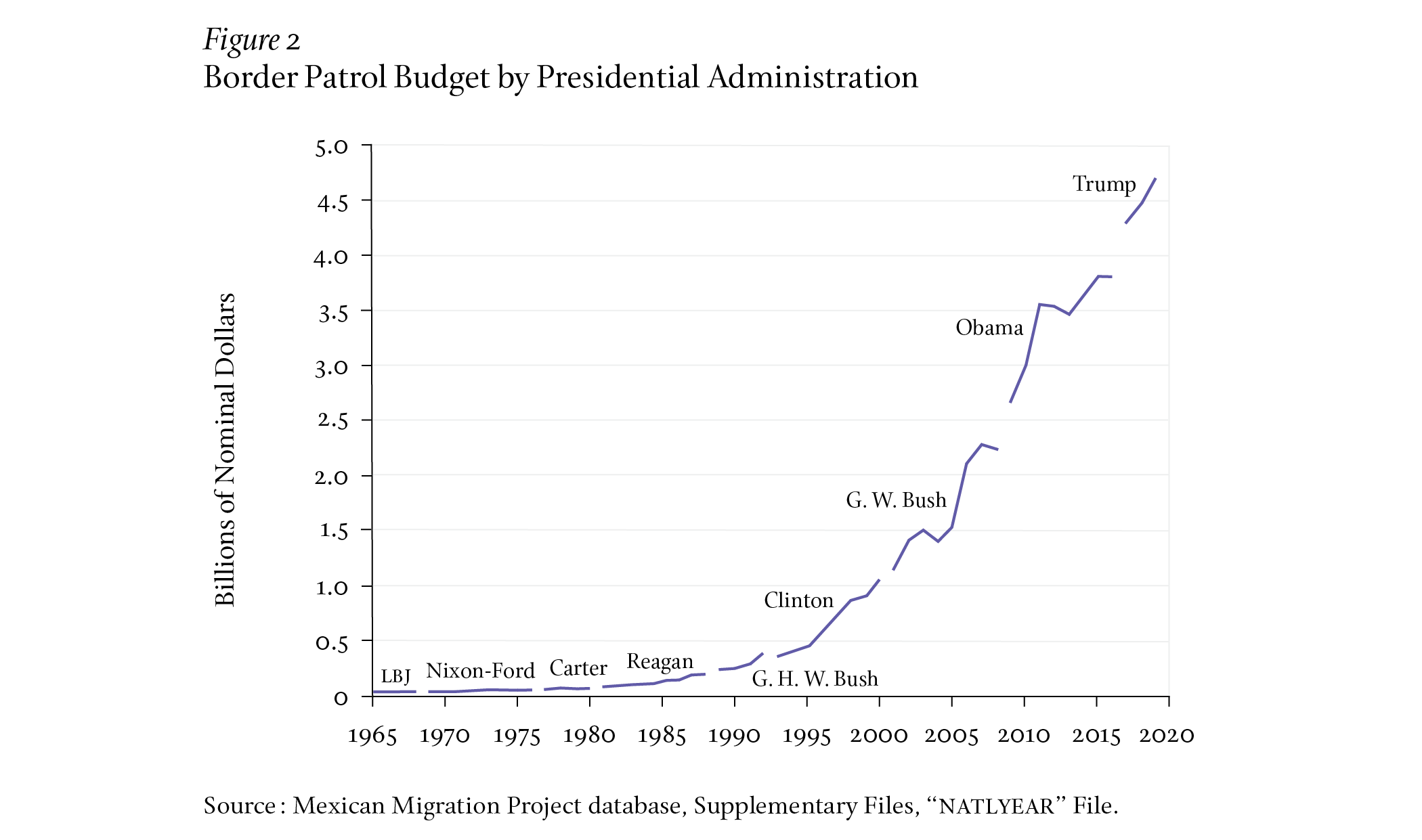
In addition to militarizing the border, beginning in the mid-1990s, successive administrations dramatically increased the budget for immigrant detention and removal from the nation’s interior, again in the name of the war on terror. In response to the 1993 bombing of the World Trade Center, in 1996, a bipartisan majority in Congress passed and President Clinton signed the Anti-Terrorism and Effective Death Penalty Act, which authorized the expedited removal of noncitizens. In the same year, Congress also passed and Clinton signed the Illegal Immigration Reform and Immigrant Responsibility Act, which increased the budget for deportation and narrowed the criteria for claiming asylum. After September 11, 2001, Congress overwhelmingly and virtually without debate passed and President Bush signed the USA PATRIOT Act, creating the Department of Homeland Security and further increasing funds for the surveillance and deportation of foreigners and authorizing the deportation of noncitizens without due process.
As shown in Figure 3, these legislative acts dramatically increased the budget for interior enforcement and removal. From 1965 through 2002, this budget is proxied by the annual budget of the Immigration and Naturalization Service (INS) for nonborder operations. From 2003 onward, the budget for interior enforcement is more precisely indicated by funding for Immigration and Customs Enforcement, a new agency created by the PATRIOT Act. As can be seen, the trend line rises slowly during the Johnson, Nixon, Ford, and Carter administrations, but toward the end of the Reagan administration, the budget experiences a notable bump upward and continues to rise at an elevated pace through the first Bush administration.
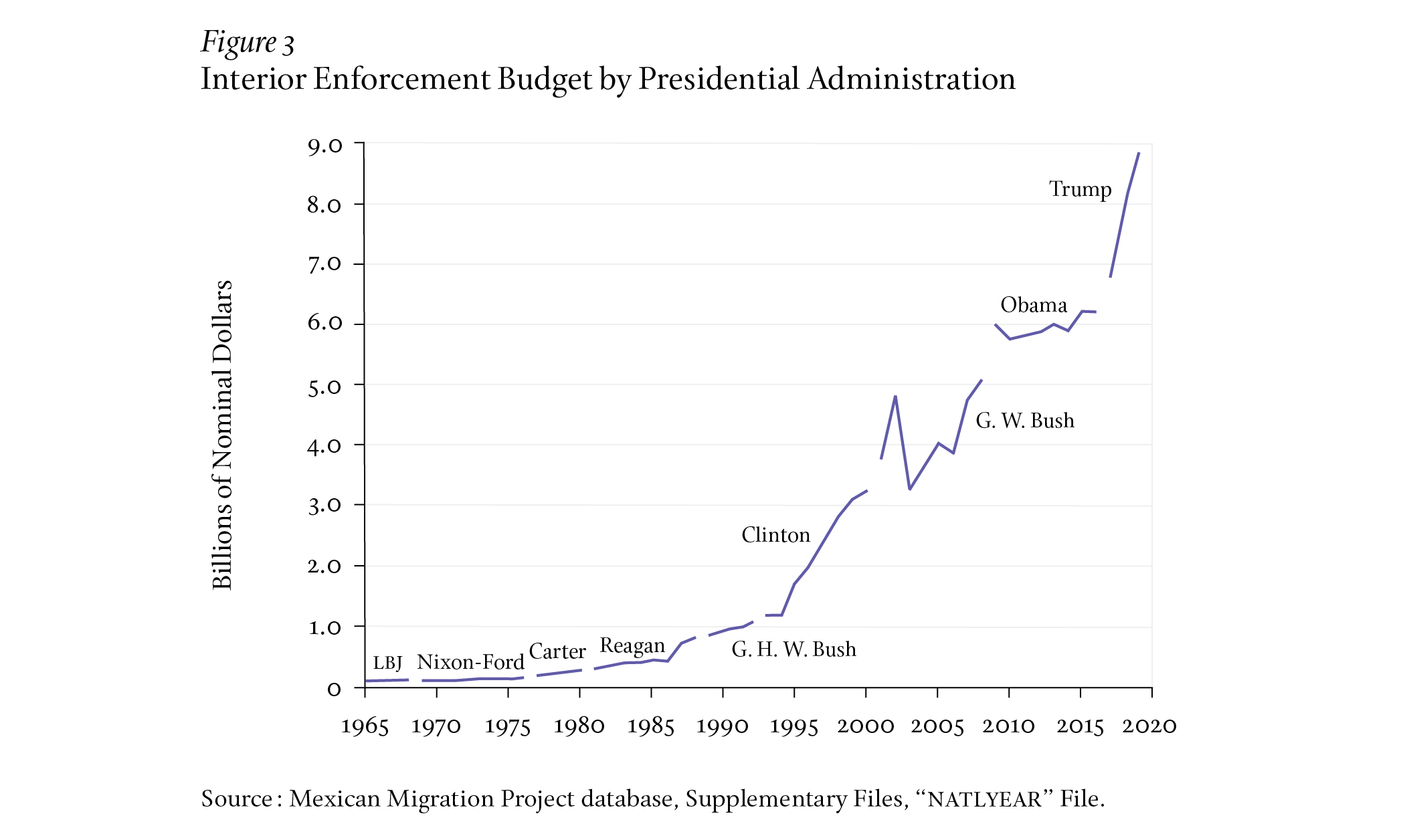
After sagging during the first two years of the Clinton administration, the curve rises dramatically for the next six years and then accelerates further during the first two years of the second Bush administration, pushing the budget upwards from $1.2 billion in 1994 to $4.8 billion in 2002. The abrupt drop in the curve between 2002 and 2003 is an artifact of the shift in indicators. Thereafter, however, the upward trajectory resumes at an even faster pace, with the ICE budget rising from $3.3 billion in 2003 to $5.1 billion in 2008. During the first year of the Obama administration, the ICE budget momentary tops out at nearly $6 billion before dropping slightly and then rising unevenly to $6.2 billion in Obama’s final year. During the first year under President Trump, the budget shot up to $6.8 billion and then continued to rise almost vertically to $8.8 billion in 2019.
Obama’s scaling back of the budget between 2008 and 2015 is not reflected in the number of migrants removed from the country, which is depicted in Figure 4. Prior to 1996, annual deportations from within the United States were in the tens of thousands with no strong trend upward. From 1995 to 2000, the annual number removed rose from 51,000 to 288,500 under Clinton and then jumped to 360,000 under President George W. Bush before reaching its all-time high of 432,000 in 2013 under Obama. Across three administrations, the total deported rose from 870,000 under Clinton, to 2 million under Bush, to 3.1 million under Obama, earning him the sardonic moniker “Deporter in Chief.”
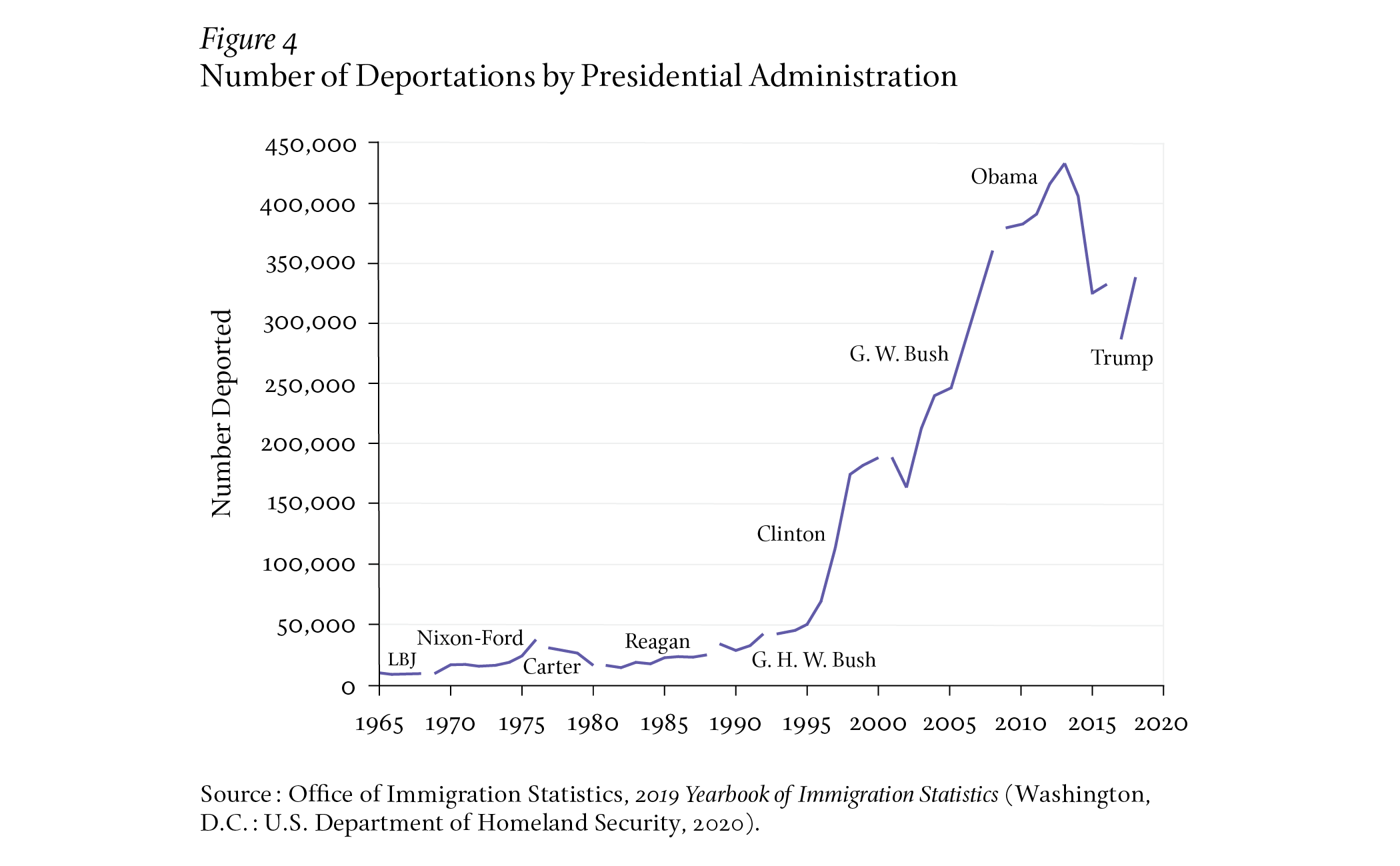
Although deportations fell sharply during Obama’s second term, removals increased once again under Trump. What set Trump apart from his predecessors, however, was not his detention of settled migrants captured within the United States, but his use of the immigrant detention system to house migrants apprehended along the border. As the huge inflow of undocumented Mexican migrant workers was replaced by a much smaller inflow of Central American families seeking asylum, Trump refused to hear their claims for asylum at ports of entry along the border and turned them back, compelling them to cross the border without authorization and then to lodge a claim for defensive asylum upon being captured.
The number of persons annually funneled through the immigrant detention system is shown in Figure 5. As deportations accelerated under Clinton, Bush, and Obama, logically so did the annual number of detentions until Obama elected to scale back deportations in his second term. From just 23,000 detentions in 1993, the number rose to 210,000 at the end of the Clinton administration and 379,000 at the end of the Bush administration. Under Obama, detentions peaked at 464,000 in 2012 and then declined sharply as he scaled back deportation efforts. Although Figure 4 shows that the number of deportations under Trump in 2018 was roughly equal to that prevailing at the end of the Obama administration, total detentions under Trump skyrocketed to almost 600,000 as the detention system filled up with Central American women and children seeking refuge rather than Mexicans moving to jobs in the United States.
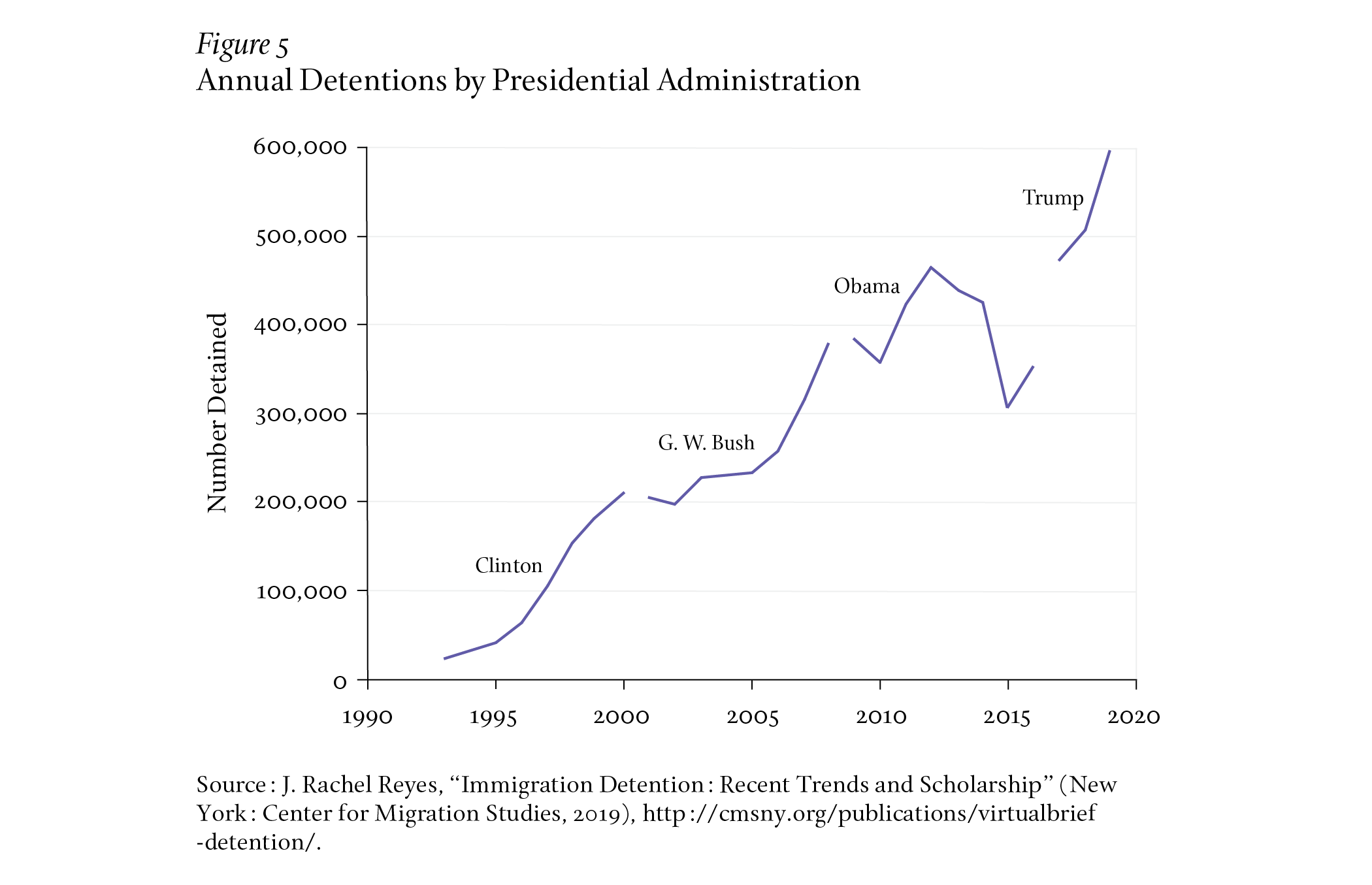
The essays in this issue of Dædalus make it clear that White racial resentment lies at the core of support for the Republican Party today, and that the party’s animus toward Black Americans, actively cultivated since the 1960s, has now broadened to include Hispanics. The rising political agency of African Americans and a changing racial demography together created a powerful status threat to conservative White Americans. As Democratic attitudes moved decisively away from racist, nativist sentiments, the Republican base doubled down to embrace a reactionary politics of White identity grounded in fear.
Both the racialization of Latinos around the trope of illegality and the extraordinary growth of the Hispanic population were made possible by dysfunctional immigration and border policies implemented in equal measure under both Democratic and Republican administrations. Rather than challenging the narrative of a cross-border alien invasion, Democrats in Congress and the White House co-opted it in the futile hope of pushing Republicans toward support for immigration reform. It was Bill Clinton who promulgated the strategy of “prevention through deterrence” that militarized the Mexican-U.S. border; and it was Clinton who unleashed the formidable regime of mass deportation upon the nation. Barack Obama subsequently increased the number of deportations and Border Patrol officers to all-time record highs.
At this writing, Joe Biden is days away from being inaugurated as the 46th President of the United States. His victory was not accompanied by the hoped-for “blue wave,” however. Some 48 percent of the electorate still voted for Trump despite his calamitous performance in managing the COVID-19 pandemic. Since the election, the president has assiduously worked to discredit the election as stolen and Biden’s presidency as illegitimate. The Republican Party has become increasingly undemocratic and authoritarian, deploying a cynical hardball politics of misinformation, court packing, and voter suppression in order to perpetuate White minority rule in a rapidly diversifying nation.
Upset victories in the Georgia runoff elections have just ensured Democratic control of both chambers of Congress, offering the party a chance to make amends for its part in propagating the nation’s war on immigrants. Democrats need to abandon the fiction that a militarized Southern border somehow contributes to the nation’s security and that the mass deportation of Hispanics in some way protects Americans from harm. The truth is that America’s over-the-top immigration enforcement machine is a costly symbolic charade that wastes taxpayer dollars, needlessly takes lives, and rips gaping holes in the nation’s social fabric.
Two reports prepared by the National Academy of Sciences conclude that immigrants are a net benefit to the U.S. economy and that they are integrating well and rapidly into U.S. society–if they are unhindered by a lack of legal status.32 To realize the full social and economic potential of immigrants who are already in our midst, the legal barriers to full participation must be removed. To achieve this end, the United States must 1) grant immediate legal permanent residence to the young people who registered under the program of Deferred Action for Childhood Arrivals (DACA) and others who entered the country as minors; 2) bestow legal permanent residence upon those currently in Temporary Protected Status, who often have been living and working legally in the United States for decades; 3) create a path to legal residence for undocumented residents who entered as adults but have no criminal record aside from immigration violations and misdemeanor infractions; and 4) recognize our moral obligation to Central Americans fleeing deleterious circumstances that stem directly from U.S. intervention in the region during the 1980s by processing their asylum claims rather than detaining them.
Although most of the essays in this volume are rather bleak in their assessment of policies and practices leading up to the 2016 election of a White nationalist administration, the collection’s final contribution by Richard Alba, “The Surge of Young Americans from Minority-White Mixed Families & Its Significance for the Future,” paints a far more optimistic future. Rather than seeing a tension-ridden “majority-minority” society of non-Hispanic Whites competing with a majority of racially distinct others, his careful assessment of the demographic evidence suggests a future of integration, adaptation, and peaceful accommodation in which intergroup boundaries blur rather than harden. What is necessary for the full realization of this vision is the full legalization of the roughly eleven million people who now peacefully live among us without legal permanent residence.
